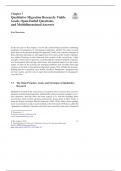Chapter 7
Qualitative Migration Research: Viable
Goals, Open-Ended Questions,
and Multidimensional Answers
Ewa Morawska
In the first part of this chapter, I review the epistemological premises informing
qualitative investigations of international migration; identify the main research
goals that can be pursued through this approach; briefly note relevant strategies of
data collection and analysis; and suggest how best to present the results of qualita-
tive studies. Drawing on the framework thus created, in the second part, I offer
examples of the kinds of questions raised through the standard methods of qualita-
tive investigation (interviewing, observation, and document analysis) in the exami-
nation of some of the existing and emerging problems that currently preoccupy
scholars in the field of international migration studies. They include the decision-
making process of potential cross-border travellers, immigrants’ integration into
the host society, and the role of super-diversity/multiculturalism in immigrants’
everyday lives.
7.1 The Main Premises, Goals, and Strategies of Qualitative
Research
Qualitative research in the social sciences in general and, of concern here, in inves-
tigations of international migration, traditionally aims to reconstruct people’s every-
day experience, both the inner and outer aspects of it, with the meanings those
social actors attach to their situations and pursuits. It pays heed, in other words, to
what the Polish sociologist Florian Znaniecki (1882–1958), under whose guiding
star I was trained in social research methods at the University of Warsaw, called the
“humanistic coefficient”. Because social facts are created by social actors, Znaniecki
E. Morawska (*)
University of Essex, Colchester, UK
e-mail: emorawsk@essex.ac.uk
© The Author(s) 2018 113
R. Zapata-Barrero, E. Yalaz (eds.), Qualitative Research in European Migration
Studies, IMISCOE Research Series,
https://doi.org/10.1007/978-3-319-76861-8_7
,114 E. Morawska
insisted, the former can only genuinely be understood from the perspective of the
latter (Znaniecki 1934). In order to take the humanistic coefficient in any given
context into account researchers need to assume the perspective of the people whose
lives are being examined. In short, they need what in the German tradition of verste-
hende or interpretative sociology is described as Einfühlung, empathy – quite liter-
ally the ability to sense what is going on in another person’s mind or heart.
Sociological research in the verstehende tradition represents a micro-level type of
investigations into the social world conducted, however, with what C. Wright Mills
referred to as the sociological imagination or, in his words, “the vivid awareness of
in the relationship between personal experience and the wider world” (1959, p. 7).
Qualitative research approaches the meaningful social action—the core concern, on
Max Weber’s account (1968), of sociological analysis – as inherently polymorphous
and constantly assuming new forms as it unfolds, all of which should ideally be
reflected in the collected data and its interpretation. Consequently, qualitative
researchers are natural bricoleurs, “Jacks (and Jennies) of all trades”, mixing and
blending and, where necessary, reconfiguring a diverse range of methods and rele-
vant insights (Denzin and Lincoln 2008, pp. 3–4) to render complex, multidimen-
sional, and frequently “fuzzy” assessments of the examined situations. While this
methodology of mixing, blending, and reconfiguring compounds the inherent diver-
sity of the dynamic everyday functioning of social worlds and the human actors who
(re)create them, qualitative analyses can, as I will argue, nevertheless facilitate the
systematic pursuit of a variety of research goals and significantly expand our under-
standing of the social worlds we explore.
Qualitative research also focuses on the centrality of what Znaniecki (1934)
called the “kinetic” or processual nature of social phenomena, which requires ana-
lytical attention to the temporal dimension of human lives. In his now classic essay,
“Historical Sociology and Time” (1992), the American historical sociologist Ronald
Aminzade distinguishes four dimensions of time whose effects should be consid-
ered by researchers approaching their object of study as processual rather than
fixed: duration, pace, trajectory, and rhythm. Duration is relevant, for example,
when the varying lengths of time an immigrant may have spent in the host country
without authorization are likely to affect his or her prospects of mainstream employ-
ment. The differential impact of immigrants’ sporadic vs. frequent journeys to their
home country on the scope of their integration into the host society is a question of
pace. For immigrants who came to the host country as children and completed their
education there before entering the job market, the processes of socioeconomic inte-
gration are likely to differ markedly from those of their fellow nationals who arrived
as grown-ups with occupational specializations acquired in the home country. These
are questions of trajectory. The (ir)regularity with which immigrants experience
everyday racial or religious rejection and discrimination, and the impact of that
experience on the pace of their integration is a matter of rhythm.
Founded on the premise of the multi-dimensional and multi-form nature of
human activities and the social world they create, which informs qualitative social
science research, qualitative investigations render the representations of the anal-
ysed phenomena as inherently diverse, complex, and often “fuzzy”. Adding to the
, 7 Qualitative Migration Research: Viable Goals, Open-Ended Questions… 115
amorphousness or under-determinacy of the outcomes of qualitative investigations
are intended and unintended misrepresentations produced by the subjects of our
investigations as well as the omissions and biases of the researchers themselves.
Even with the critical assessment of the examined sources and the researcher’s self-
reflexive account of his/her impositions on the collected evidence (for good discus-
sions of the what and how of self-reflexivity, see Denzin and Lincoln 2008; Lofland
and Lofland 2006; Alvesson and Skoldberg 2012; Iosifides 2011, 2018), the repre-
sentations of the social world and its human actors produced through qualitative
investigations are, as most of the contemporary practitioners of this approach agree,
unavoidably “gappy” and incomplete. Yet while the qualitative approach may not
produce perfect, mirror-like representations of the phenomena it investigates, its
practitioners are by no means abandoning the standards of scholarly practice.
Rather, they are intellectually comfortable with their commitment to achieving the
greatest possible measure of verisimilitude or the closest achievable approximation
of their objects of study (this case has been persuasively argued, for instance, by
Hammersley 1995, Atkinson 1990, and Madison 2012). Well executed qualitative
studies, in our case of issues related to international migration, which achieve a high
measure of verisimilitude generate rich, multi-layered, and nuanced accounts of the
ways in which various aspects of the everyday immigrant experience evolve and
unfold. The main strength of the qualitative approach in the social sciences lies in
its ability to render more accurate representations of the actual life-worlds of those
who inhabit them than purely quantitative surveys and analyses can.
As they become acquainted with the state of knowledge in the specific field of
their investigation, the researchers should decide on the specific goal(s) that will
guide their data collection and analysis. Charles Ragin (1994) has specified seven
purposes informing social-science research: (i) identifying general patterns and
relationships; (ii) testing and refining theories and guiding concepts; (iii) making
predictions; (iv) interpreting culturally or historically significant phenomena; (v)
exploring diversity; (vi) giving voice; and (vii) advancing new theories. On Ragin’s
account, qualitative research is conducive to the pursuit of three of his seven possi-
ble goals: the interpretation of culturally or historically significant phenomena, the
exploration of diversity, and the lending of a voice.
In migration studies, the interpretation of culturally or historically significant
phenomena is important, for instance, in assessing the transnational engagements of
present-day immigrant-members of racial minorities in Europe, which are signifi-
cant for their individual and collective self-esteem, or their likely impact on the
immigrants’ future integration into the mainstream of the host societies.
The qualitative exploration of diversity encompasses the probing of variations
within phenomena or of deviations from patterns generally acknowledged in the
relevant field of study. This might concern, for example, gender and/or racial sub-
varieties of the segmented assimilation modes generally governing immigrants’
integration into the host society, or a sustained transnational investment of immi-
grants’ grandchildren in their forbears’ home country, which does not conform to
the more usual gradual inter-generational weakening of this kind of engagement.






